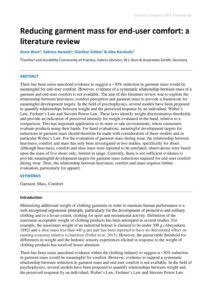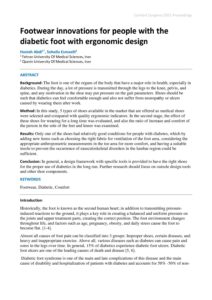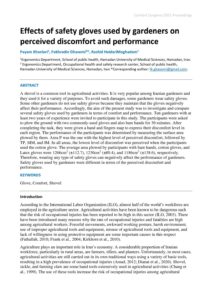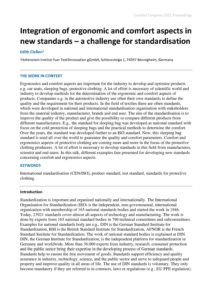Publish Date: Aug 16, 2021 | Keywords: Clothing, Comfort, Comfort Congress 2021, Publications
 |
Author
Anna West, Sabrina Herzele, Günther Schlee & Alex Karahalis |
Abstract
There has been some anecdotal evidence to suggest a ~30% reduction in garment mass would be meaningful for end-user comfort. However, evidence of a systematic relationship between mass of a garment and end-user comfort is not available. The aim of this literature review was to explore the relationship between heaviness, comfort perception and garment mass to provide a framework for meaningful development targets. In the field of psychophysics, several models have been proposed to quantify relationships between weight and the perceived response by an individual; Weber’s Law, Fechner’s Law and Stevens Power Law. These laws identify weight discrimination thresholds and provide an indication of perceived intensity for weight evaluated in the hand, relative to a comparison. This has important application to in-store or sale environments, where consumers evaluate products using their hands. For hand evaluations, meaningful development targets for reductions in garment mass should therefore be made with consideration of these models and in particular Weber’s Law. For the evaluation of garment mass during wear, the relationship between heaviness, comfort and mass has only been investigated in two studies, specifically for shoes. Although heaviness, comfort and shoe mass were reported to be unrelated, observations were based upon the mass of five shoes only, limited in range. Currently, there is not sufficient evidence to provide meaningful development targets for garment mass reductions required for end-user comfort during wear. Thus, the relationship between heaviness, comfort and mass requires further evaluation, particularly for apparel. |
Publish Date: Aug 16, 2021 | Keywords: Climate change, Clothing, Comfort, Comfort Congress 2021, Perception, Publications
 |
Author
Julia Wilfling, George Havenith, Margherita Raccuglia & Simon Hodder |
Abstract
Consumers are the driving force behind innovations in sportswear. Their demand for supportive and performance enhancing sportswear is increasing. The requirement for comfort in sports garments is fundamental, but its multifactorial nature makes it difficult to easily define. Whilst literature commonly gives a division of comfort in terms of psychological, physical (sensorial/tactile) and physiological comfort there is hardly a definition of clothing comfort from a consumer’s perspective. Within the sports garment’s development the choice of fabric is an integral part and has effects on the overall appearance and performance. Sports garments are manufactured from a combination of natural and synthetic fibres in knitted or woven materials. Product information labels and webpages state fibre contents and are used to identify the composition of the garment; however, consumers need knowledge of which properties are associated with the product attributes. This study explored factors contributing to the clothing comfort concept from a consumer perspective. Priorities of attributes contributing to the concept varied according to the person’s sex. Females put more emphasis on garment fit, whereas males prioritised physiological comfort descriptors. A conceptualised feel in regard to commonly known textile materials taking sex into consideration was identified. A preference for cotton fibres in females and for polyester fibres in males was found. For the apparel industry, information on product attributes from a consumer perspective is key for an effective product development. |
Publish Date: Aug 16, 2021 | Keywords: Clothing, Comfort, Comfort Congress 2021, Design, Publications
 |
Author
Hanieh Abdi, Soheila Esmaeili |
Abstract
Background: The foot is one of the organs of the body that have a major role in health, especially in diabetics. During the day, a lot of pressure is transmitted through the legs to the knee, pelvis, and spine, and any motivation in the shoe may put pressure on the gait parameters. Shoes should be such that diabetics can feel comfortable enough and also not suffer from neuropathy or ulcers caused by wearing them after work. Method: In this study, 5 types of shoes available in the market that are offered as medical shoes were selected and compared with quality ergonomic indicators. In the second stage, the effect of these shoes for wearing for a long time was evaluated, and also the ratio of increase and comfort of the person in the sole of the feet and knees was examined. Results: Only one of the shoes had relatively good conditions for people with diabetes, which by adding new items such as choosing the right fabric for ventilation of the foot area, considering the appropriate anthropometric measurements in the toe area for more comfort, and having a suitable insole to prevent the occurrence of musculoskeletal disorders in the lumbar region could be sufficient. Conclusion: In general, a design framework with specific tools is provided to have the right shoes for the proper use of diabetics in the long run. Further research should focus on outsole design tools and other shoe components. |
Publish Date: Aug 16, 2021 | Keywords: Clothing, Comfort, Comfort Congress 2021, Publications, Tools & techniques
 |
Author
Payam Khanlari, Fakhradin Ghasemi, Rashid HeidariMoghadam |
Abstract
A shovel is a common tool in agricultural activities. It is very popular among Iranian gardeners and they used it for a variety of purposes. To avoid such damages, some gardeners wear safety gloves. Some other gardeners do not use safety gloves because they maintain that the gloves negatively affect their performance. Accordingly, the aim of the present study was to investigate and compare several safety gloves used by gardeners in terms of comfort and performance. Ten gardeners with at least two years of experience were invited to participate in this study. The participants were asked to plow the ground with two commonly-used gloves and also bare hands for 30 minutes. After completing the task, they were given a hand and fingers map to express their discomfort level in each region. The performance of the participants was determined by measuring the surface area plowed by them. Area P was the one with the highest level of perceived discomfort, followed by TP, MM, and IM. In all areas, the lowest level of discomfort was perceived when the participants used the cotton glove. The average area plowed by participants with bare hands, cotton gloves, and Latex gloves were 1266cm2 (±112.7), 1230cm2 (±80.4), and 1186cm2 (±138.6), respectively. Therefore, wearing any type of safety gloves can negatively affect the performance of gardeners. Safety gloves used by gardeners were different in terms of the perceived discomfort and performance. |
Publish Date: Aug 18, 2021 | Keywords: Clothing, Comfort, Comfort Congress 2021, Publications
 |
Author
Edith Claßen |
Abstract
Ergonomics and comfort aspects are important for the industry to develop and optimize products e.g. car seats, sleeping bags, protective clothing. A lot of effort is necessary of scientific world and industry to develop methods for the determination of the ergonomic and comfort aspects of products. Companies e.g. in the automotive industry use often their own standards to define the quality and the requirement for their products. In the field of textiles there are often standards, which were developed in national and international standardisation organisation with stakeholders from the material industry, manufacturer, brands and end user. The aim of the standardisation is to improve the quality of the product and give the possibility to compare different products from different manufacturers. E.g., the standard for sleeping bag was developed as national standard with focus on the cold protection of sleeping bags and the practical methods to determine the comfort. Over the years, the standard was developed further to an ISO standard. Now, this sleeping bag standard is used all over the world to guarantee the quality and comfort parameters. Comfort and ergonomics aspects of protective clothing are coming more and more in the focus of the protective clothing producers. A lot of effort is necessary to develop standards in this field from manufactures, scientist and end users. In this talk, different examples fare presented for developing new standards concerning comfort and ergonomics aspects. |





